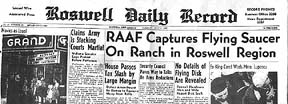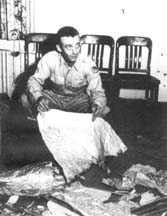Roswell Incident
In the summer of 1947, there were a number of
UFO sightings in the United States.
Sometime during the first week of July 1947, something crashed near Roswell.
W.W. "Mack" Brazel, a New Mexico rancher, saddled up his horse and rode out
with the son of neighbors Floyd and Loretta Proctor, to check on the sheep
after a fierce thunderstorm the night before. As they rode along, Brazel
began to notice unusual pieces of what seemed to be metal debris, scattered
over a large area. Upon further inspection, Brazel saw that a shallow
trench, several hundred feet long, had been gouged into the land.
Brazel was struck by the unusual properties of the debris, and after
dragging a large piece of it to a shed, he took some of it over to show the
Proctors in 1947. Mrs. Proctor moved from the ranch into a home nearer to
town, but she remembers Mack showing up with strange material.
The Proctors told Brazel that he might be holding wreckage from a UFO or a
government project, and that he should report the incident to the sheriff. A
day or two later, Mack drove into Roswell where he reported the incident to
Sheriff George Wilcox, who reported it to Intelligence Officer, Major Jesse
Marcel of the 509 Bomb Group, and for days thereafter, the debris site was
closed while the wreckage was cleared.
On July 8, 1947, a press release stating that the wreckage of a crashed disk
had been recovered was issued by Lt. Walter G. Haut, Public Information
Officer at RAAB under order from the Commander of the 509th Bomb Group at
Roswell, Col. William Blanchard.
Hours later the first press release was rescinded and the second press
release stated that the 509th Bomb Group had mistakenly identified a weather
balloon as wreckage of a flying saucer was issued July 9, 1947.
Meanwhile, back in Roswell, Glenn Dennis, a young mortician working at the
Ballard Funeral Home, received some curious calls one afternoon from the
morgue at the air field. It seems the Mortuary Officer needed to get a hold
of some small hermetically sealed coffins,and wanted information about how
to preserve bodies that had been exposed to the elements for a few days,
without contaminating the tissue.
Dennis drove out to the base hospital later that evening where he saw large
pieces of wreckage with strange engravings on one of the pieces sticking out
of the back of a military ambulance. Upon entering the hospital he started
to visit with a nurse he knew, when suddenly he was threatened by military
police and forced to leave.
The next day, Dennis met with the nurse. She told him about the bodies and
drew pictures of them on a prescription pad. Within a few days she was
transferred to England, her whereabouts remain unknown.
According to the research of Don Schmitt and Kevin Randle, in their book, A
History of UFO Crashes, from which the following account of the Roswell
Incident , in part, is based, the military had been watching an unidentified
flying object on radar for four days in southern New Mexico. On the night of
July 4, 1947, radar indicated that the object was down around thirty to
forty miles northwest of Roswell.
Eye witness William Woody, who lived east of Roswell, remembered being
outside with his father the night of July 4, 1947, when he saw a brilliant
object plunge to the ground. A couple of days later when Woody and his
father tried to locate the area of the crash, they were stopped by military
personnel, who had cordoned off the area.
Acting on the call from Sheriff Wilcox, Intelligence Officer, Major Jesse
Marcel was sent by Col. William Blanchard, to investigate Mack Brazel's
story.
Marcel and Senior Counter Intelligence Corps (CIC) agent, Captain Sheridan
Cavitt, followed the rancher off-road to his place. They spent the night
there and Marcel inspected a large piece of debris that Brazel had dragged
from the pasture.
Monday morning, July 7, 1947, Major Jesse Marcel took his first step onto
the debris field. Marcel would remark later that "something... must have
exploded above the ground and fell." As Brazel, Cavitt and Marcel inspected
the field, Marcel was able to "determine which direction it came from, and
which direction it was heading. It was in the pattern... you could tell
where it started out and where it ended by how it was thinned out..."
According to Marcel, the debris was "strewn over a wide area, I guess maybe
three-quarters of a mile long and a few hundred feet wide." Scattered in the
debris were small bits of metal that Marcel held a cigarette lighter to, to
see if it would burn. "I lit the cigarette lighter to some of this stuff and
it didn't burn", he said.
Along with the metal, Marcel described weightless I-beam-like structures
that were 3/8" x 1/4", none of them very long, that would neither bend nor
break. Some of these I-beams had indecipherable characters along the length,
in two colors. Marcel also described metal debris the thickness of tin foil
that was indestructible.
After gathering enough debris to fill his staff car, Maj. Marcel decided to
stop by his home on the way back to the base so that he could show his
family the unusual debris. He'd never seen anything quite like it. "I didn't
know what we were picking up. I still don't know what it was...it could not
have been part of an aircraft, not part of any kind of weather balloon or
experimental balloon...I've seen rockets... sent up at the White Sands
Testing Grounds. It definitely was not part of an aircraft or missile or
rocket."
Under hypnosis conducted by Dr. John Watkins in May of 1990, Jesse Marcel
Jr. remembered being awakened by his father that night and following him
outside to help carry in a large box filled with debris. Once inside, they
emptied the contents of the debris onto the kitchen floor.
Jesse Jr. described the lead foil and I-beams. Under hypnosis, he recalled
the writing on the I-beams as "Purple. Strange. Never saw anything like
it...Different geometric shapes, leaves and circles." Under questioning,
Jesse Jr. said the symbols were shiny purple and they were small. There were
many separate figures. This too, under hypnosis: [Marcel Sr. was saying it
was a flying saucer] "I ask him what a flying saucer is. I don't know what a
flying saucer is...It's a ship. [Dad's] excited!"
 At 11:00 A.M Walter Haut, public
relations officer, finished the press release he'd been ordered to write,
and gave copies of the release to the two radio stations and both of the
newspapers. By 2:26 P.M., the story was out on the AP Wire: At 11:00 A.M Walter Haut, public
relations officer, finished the press release he'd been ordered to write,
and gave copies of the release to the two radio stations and both of the
newspapers. By 2:26 P.M., the story was out on the AP Wire:
"The Army Air Forces
here today announced a flying disk had been found"
As calls began to pour into the base from all over the world, Lt. Robert
Shirkey watched as MPs carried loaded wreckage onto a C-54 from the First
Transport Unit.
To get a better look, Shirkey stepped around Col. Blanchard, who was
irritated with all of the calls coming into the base. Blanchard decided to
travel out to the debris field and left instructions that he'd gone on
leave.
On the morning of July 8, Marcel reported what he'd found to Col. Blanchard,
showing him pieces of the wreckage, none of which looked like anything
Blanchard had ever seen. Blanchard then sent Marcel to Carswell [Fort Worth
Army Air Field] to see General Ramey, Commanding Officer of the Eighth Air
Force.
Marcel stated years later to Walter Haut that he'd taken some of the debris
into Ramey's office to show him what had been found. The material was
displayed on Ramey's desk for the general when he returned.

Upon his return, General Ramey wanted to see the exact location of the
debris field, so he and Marcel went to the map room down the hall - but when
they returned, the wreckage that had been placed on the desk was gone and a
weather balloon was spread out on the floor. Major Charles A. Cashon took
the now-famous photo of Marcel with the weather balloon, in General Ramey's
office.
It was then reported that General Ramey recognized the remains as part of a
weather balloon. Brigadier General Thomas DuBose, the chief of staff of the
Eighth Air Force said, "[It] was a cover story. The whole balloon part of
it. That was the part of the story we were told to give to the public and
news and that was it."
The military tried to convince the news media from that day forward that the
object found near Roswell was nothing more than a weather balloon.
July 9, as reports went out that the crashed object was actually a weather
balloon, clean-up crews were busily clearing the debris. Bud Payne, a
rancher at Corona, was trying to round up a stray when he was spotted by
military and carried off the Foster ranch, and Jud Roberts along with Walt
Whitmore were turned away as they approached the debris field.
As the wreckage was brought to the base, it was crated and stored in a
hangar.
Back in town, Walt Whitmore and Lyman Strickland saw their friend, Mack
Brazel, who was being escorted to the Roswell Daily Record by three military
officers. He ignored Whitmore and Strickland, which was not at all like
Mack, and once he got to the Roswell Daily Record offices, he changed his
story. He now claimed to have found the debris on June 14. Brazel also
mentioned that he'd found weather observation devices on two other
occasions, but what he found this time was no weather balloon.
Later that afternoon, an officer from the base retrieved all of the copies
of Haut's press release from the radio stations and newspaper offices.
The Las Vegas Review Journal, along with dozens of other newspapers, carried
the AP story:
"Reports of flying saucers whizzing through the sky fell off sharply today
as the army and the navy began a concentrated campaign to stop the rumors."
The story also reported that AAF Headquarters in Washington had "delivered a
blistering rebuke to officers at Roswell."
|

